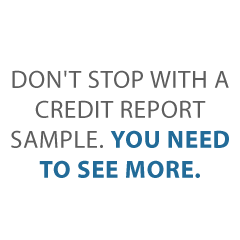Your business credit isn’t the only thing that affects your ability to get funding. Still, it is a huge piece of the pie. One way to see your business credit and get a feel for where you stand is to get a credit report sample.
A Free Credit Report Sample Can Help You Know Where to Start with Funding and Fundability
Unlike your personal credit report, you can’t really get a free copy of a business credit report. However, you can get a sneak peak in some cases with these options.
Nav
So, Nav is a service that will let you see a credit report sample from all three of the major credit reporting agencies. But these are only summaries, not full reports. Generally, that means you can see your score, and maybe the accounts you have listed. While this will help you get your bearings, it will not suffice for the purpose of correcting mistakes or even to show you what you need to do to improve your score. You do have the option to pay for more information though.
Credit.net
Similarly, Credit.net will let you see a credit report sample with their free trial. There is no credit card required. Also, after you pull the report, you have 30 days to check it out. As a result, at least once you can get a totally free look at your report. Since there is no fear of missing a cancelation deadline and having to pay anyway, it’s a great option.
Scorely
Scorely offers you a credit report sample before you pay for an ongoing subscription. In contrast to Nav or Credit.net, they actually calculate their own score similar to the big 3: Experian, Equifax, and Dun & Bradstreet. They strive to be totally transparent and to make their reports easy to understand.
CreditSafe
You do have to pay for an ongoing subscription to CreditSafe. However, they will give you a credit report sample to get you started. Also, they have a number of reports that are unique to them. This means you are getting something that you may not get with the other monitoring services or even the standard reports from Dun & Bradstreet, Experian, or Equifax.
How To Read Your Credit Report Sample
In truth, each reporting agency offers different types of reports and information. Similarly, they all contain the same general data. You need to understand what your credit report sample says, whichever agency it is from, about your business.
Dun & Bradstreet
Dun & Bradstreet offers several different types of business credit reports. In fact, there are six different reporting options in all. They all offer different information related to credit worthiness, and it takes all of them to get the whole picture. The price range listed above is dependent on which reports you want to order.
The report most use is the PAYDEX. This is likely because it is the easiest to understand, due to it being the most like the consumer FICO score. It measures how quickly a customer makes payments and ranges from 1 to 100. Scores of 70 or higher are acceptable. For example, a score of 100 shows payments are made in advance, and a score of 1 indicates that they are 120 days late, or more.
The other Dun & Bradstreet Credit Reports include:
- Dun and Bradstreet Delinquency Predictor Score
The delinquency predictor score measures how likely it is that the company will not pay, will be late paying, or will fall into bankruptcy. The scale is 1 to 5, and a 2 is good.
- Financial Stress Score
The financial stress score measures pressure on the balance sheet. It shows how likely the company is to shut down within a year. These scores range from 5 to 1, with a score of 2 being a good thing.
- Supplier Evaluation Risk Rating
This rating ranks the odds of a company surviving 12 months. The minimum score is a 9 and the maximum is 1. A “good” score is 5.
- Credit Limit Recommendation
The credit limit recommendation reflects a business’s borrowing capacity. It is a recommendation for how much debt a company can handle. Typically, creditors use this to determine how much credit to extend.
- D&B Credit Rating
This one ranks overall business risk on a scale of one to four. A score of 2 is good. The rating is given in conjunction with letters, the combination of which indicates a company’s net worth.
Even if there isn’t enough information on a business to assign a regular rating, Dun and Bradstreet will assign what they call a Credit Appraisal Score. This is based on the number of employees. Another option is an alternative rating based on what data is actually available.
Experian
Experian’s uses what it calls Intelliscore as its credit ranking. There are more than 800 different factors that they use to predict a company’s credit risk. With Intelliscore, a score of 76 or higher indicates a low risk of default or late payment. If a score falls between 51 to 75, it indicates a low to medium risk. Scores from 26 to 50 are medium risk, and from 25 down to 1 is medium high to high risk.
Here is where Experian gets tricky. Intelliscore is a blended score of both the business and business owner’s personal information. That means it offers insights into a business’s public record findings, collections, and payment trends, as well as overall business background. Experian is also unique in that it does not ask businesses to self-report.
Instead, they collect all the information themselves. You will have to give permission for a lender to view this report, due to it containing personal information.
Equifax
Equifax collects information similar to Dun and Bradstreet, including: information from public records, financial data from the business, and payment history from creditors. Credit utilization is also a factor, which accounts for how much credit you are using versus the amount of credit you have available to use.
The information is used to calculate various scores, including the business credit risk score and the business failure score. The first measures how likely it is that a business will become 90 days or more delinquent on bills over the next year. The score ranges from 101 to 992. The second ranges from 1,000 to 1610 and predicts how likely it is that the business will file for bankruptcy over the next 12-month period. A lower score indicates higher risk.
They also calculate what they call the business payment index. This is the Equifax version of Dun & Bradstreet’s PAYDEX. It even runs on the same scale of 0 to 100. This is an indicator of payment history over the past year. It is different from the PAYDEX, however, in that you must reach a score of 90 or higher for it to be a good score.
In addition, Equifax offers business identity reports to confirm a company actually exists. It verifies details such as the company’s tax ID, number of employees, and yearly sales.
Equifax does not allow business owners to request reports on their own company. They decide themselves when to start a credit file on a specific company.
A Note on CreditSafe
If you want to subscribe with them after you see your credit report sample, they offer 3 packages, Standard, Plus, and Premier. The problem is, they do not list their prices on their website. You have to request a quote to determine what your pricing would be. They allow you to purchase individual products as well.
CreditSafe is quickly growing in popularity. No doubt that is partly due to the subscription service it offers, which allows easy insight into your own company’s credit report. The free trial allows for test driving, which sweetens the deal even more.
Their main score, the CreditSafe rating, works on a scale of 1-100. It predicts the likelihood that payment performance will become 90 plus days beyond terms within the next 12 months or that the business will go bankrupt. They offer a variety of other scores and reports that provide a ton of information however.
They collect data from over 8,000 sources including:
- FTSE Stock
- Telephone research
- Local Agents
- Companies House
- Gazettes
- Branches
- News
- Trade Payment Data
- Banks
- Courts
- Registry Offices
Of course, this is far less than 8,000, but it gives an idea of the sources they use to gather their information.
CreditSafe Business Credit Reports
- International Score
This score is derived from the Creditsafe rating. It allows for a comparison of credit risk between companies that are registered in different countries.
- Credit Limit
The Creditsafe recommended credit limit uses information from the business payment records and those of similar companies to calculate a dollar amount recommendation of the maximum amount of credit a company should receive at any one time.
- Days Beyond Terms (DBT)
Compares how many days late a business pays its bills in comparison to other companies in the industry.
- Derogatory Legal
This is a report on the number and value of tax liens and judgements that have been filed in the past 6 years and 9 months. It also includes bankruptcies filed in the last 9 years and 9 months
- Payment Trend
A report designed to highlight at a glance substantial changes in how a company is paying its bills.
- Business Spend Trend
Lets you know whether the total annual business spending is going up or down when compared to the previous year.
Subscription packages come in levels, and the prices depend on your business’s individual needs. You will have to speak to a consultant to get a quote.
How To Use the Information on Your Credit Report Sample
Honestly, it’s a great idea to get a credit report sample. But, what do you do with the information that is on it? Here’s what. You use it to figure out where you need to start with building stronger fundability. Truly, your business credit score isn’t the only thing that affects fundability. In fact, there are many other factors that come into play as well. However, if you have a problem with any of these other factors, it will often be detectable on your credit report sample. Once you see it, you will know what you need to work on, including business credit.
What Affects Fundability?
What are some of these other factors you can use your credit report sample to check? Here are just a few.
Other Business Data Agencies
In addition to the business credit reporting agencies that directly calculate and issue credit reports, there are other business data agencies that affect those reports indirectly. Two examples of this are LexisNexis and The Small Business Finance Exchange. These two agencies gather data from a variety of sources, including public records.
This means they could even have access to information relating to automobile accidents and liens. While you may not be able to access or change the data the agencies have on your business, you can ensure that any new information they receive is positive. Enough positive information can help counteract any negative information from the past.
If you see something on your credit report you did not expect, it may have come from one or both of these agencies.
Business Information
On the surface, it seems obvious that all of your business information should be the same everywhere it may show up. However, when you start changing things up like adding a business phone number and address or incorporating, you may find that some things slip through the cracks. If you see accounts missing from your credit report sample, or accounts on it that should not be, you may have a problem with this.
The Application Process
Consider the timing of the application. Does your credit report make it seem as if your business is currently fundable? If not, get to work.
Use Your Credit Report Sample to Build Fundability
 Of course, there are a lot of factors that affect fundability that you may not be able to use your credit report sample to check on. Still, getting a peek at what is on your business credit report is a fabulous start.
Of course, there are a lot of factors that affect fundability that you may not be able to use your credit report sample to check on. Still, getting a peek at what is on your business credit report is a fabulous start.
With the information you see, you can start making some decisions about how to create stronger business fundability. If you see an issue with any of these factors you need to work on it. Seeing a credit report sample is the first step toward detection and correction.
Also, I would encourage you, don’t stop with a credit report sample. You need to see more. Regular monitoring of your business credit is vital.


